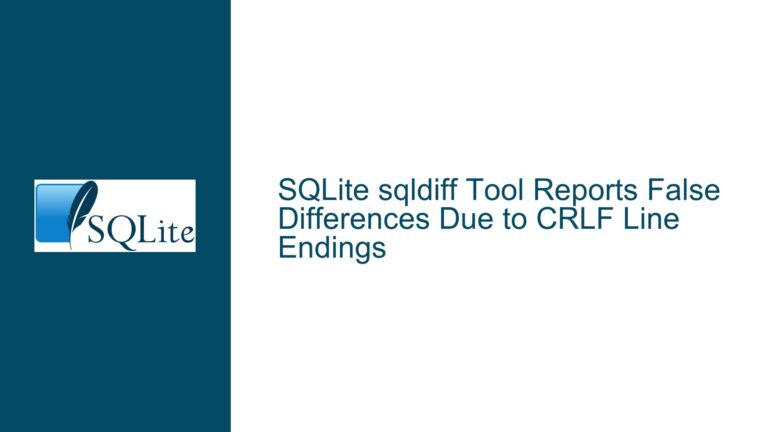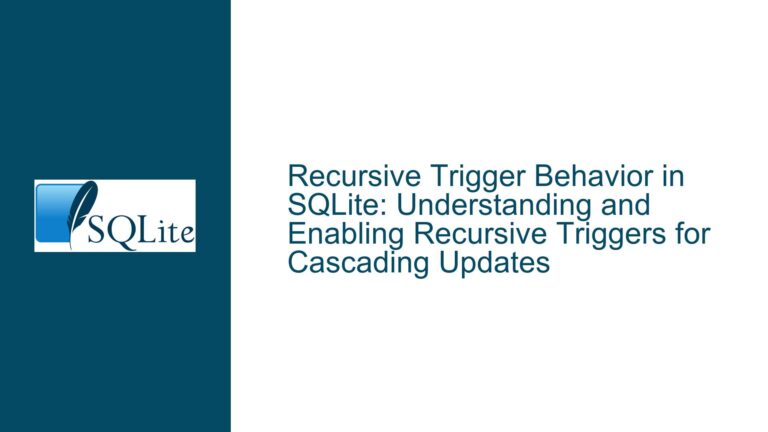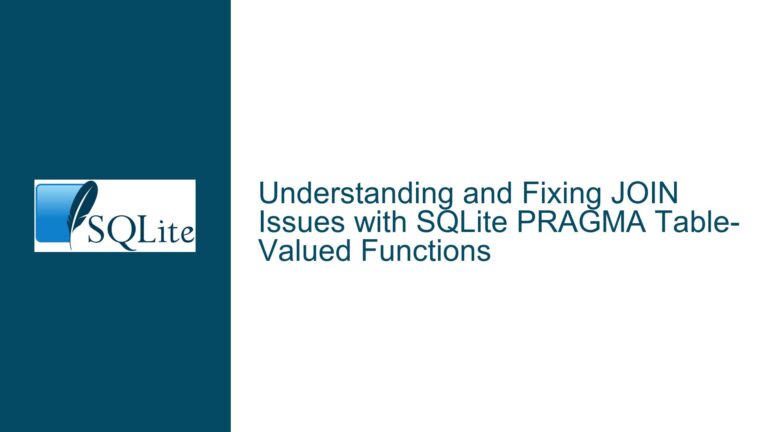Safety and Best Practices for Casting SQLite Integer Results to Smaller C Types
SQLite Integer Storage Mechanics and C Type Casting Compatibility
The core issue revolves around the interaction between SQLite’s integer storage model and the handling of retrieved integer values in C applications. SQLite stores integers using a variable-length encoding scheme, which optimizes storage space based on the magnitude of the integer. However, when accessing these values through the SQLite C API, developers must explicitly choose a function to extract the value into a specific C data type. The sqlite3_column_int() function retrieves values as 32-bit signed integers (int), while sqlite3_column_int64() retrieves them as 64-bit signed integers (long long or int64_t).
SQLite does not provide direct API functions for smaller integer types such as short (16-bit) or uint8_t (8-bit). This absence forces developers to cast the retrieved int values into smaller types manually. For example, a developer might write:
short temp = (short)sqlite3_column_int(stmt, 1);
This code assumes that the integer value in column 1 of the result set will always fit within the range of a 16-bit signed integer (-32,768 to 32,767). While this assumption might hold true for controlled datasets—such as values constrained to 0–3—it introduces risks if the underlying data changes unexpectedly. The cast operation itself is syntactically valid and will compile without errors, but its runtime safety depends entirely on the actual data retrieved.
A critical nuance lies in SQLite’s type affinity system. Even if a column is declared as INTEGER, SQLite allows storing values up to 64 bits. Applications that assume smaller value ranges must enforce these constraints through schema definitions (e.g., CHECK constraints) or application logic. Without such safeguards, data corruption or undefined behavior may occur when values exceed the target C type’s capacity.
Risks of Implicit Value Range Assumptions and Data Type Mismatches
The primary risk in casting SQLite integers to smaller C types stems from unvalidated value range assumptions. While the original poster (OP) asserts that their values will never exceed 3 or become negative, this guarantee relies entirely on the application’s current implementation. Future modifications—such as new features, altered business logic, or schema changes—could invalidate this assumption. For example, a subsequent developer might insert a value of 32,768 into the column, causing a 16-bit short variable to overflow.
Another risk arises from platform-dependent integer representations. The C standard does not mandate fixed sizes for short or int; it only specifies minimum ranges. While most modern platforms use 16-bit short and 32-bit int, this is not universal. Embedded systems or legacy architectures might have different sizes, leading to unexpected truncation or sign-extension issues. Using standardized types like int16_t or uint8_t (from <stdint.h>) eliminates this ambiguity by guaranteeing exact bit widths.
A subtler issue involves NULL handling and type conversions. If the column allows NULLs, the application must explicitly check for them using sqlite3_column_type() before accessing the value. Failing to do so could lead to interpreting a NULL as an integer zero, which might be incorrect for the application’s logic.
Mitigation Strategies for Safe Integer Casting and Value Handling
Step 1: Enforce Value Constraints at the Database Layer
Use SQL schema constraints to ensure values remain within expected ranges. For a column that should only contain 0–3:
CREATE TABLE example (
id INTEGER PRIMARY KEY,
status INTEGER NOT NULL CHECK (status BETWEEN 0 AND 3)
);
This CHECK constraint guarantees that invalid values cannot enter the database, serving as a fail-safe even if application logic changes.
Step 2: Use Exact-Width Integer Types in C Code
Replace platform-dependent types like short with standardized types:
#include <stdint.h>
uint8_t temp = (uint8_t)sqlite3_column_int(stmt, 1);
uint8_t is ideal for 0–3, as it explicitly requires an 8-bit unsigned integer. This choice documents the value range in the code and eliminates signedness ambiguities.
Step 3: Implement Runtime Value Validation
Even with schema constraints, validate values before casting:
int raw_value = sqlite3_column_int(stmt, 1);
if (raw_value < 0 || raw_value > 3) {
// Handle error: Unexpected value
}
uint8_t temp = (uint8_t)raw_value;
This adds redundancy, catching invalid values caused by bugs or direct database manipulation.
Step 4: Leverage Compiler Warnings and Static Analysis
Enable compiler flags to detect implicit truncation:
- GCC/Clang:
-Wconversion -Wsign-conversion - MSVC:
/W4
Static analyzers like Clang Analyzer or Coverity can identify unsafe casts.
Step 5: Document Assumptions and Limitations
Comment the code to clarify the expected value range and rationale for the cast:
// Column 1: Status code (0-3, enforced by CHECK constraint)
uint8_t temp = (uint8_t)sqlite3_column_int(stmt, 1);
Step 6: Test Boundary Conditions
Create unit tests that insert values at the edges of the valid range (0, 3) and just beyond them (4, -1). Verify that the application correctly handles valid values and rejects invalid ones.
Alternative Approach: Custom Helper Functions
Encapsulate the casting logic in a reusable function with built-in validation:
uint8_t get_status_column(sqlite3_stmt* stmt) {
int raw_value = sqlite3_column_int(stmt, 1);
if (raw_value < 0 || raw_value > 3) {
sqlite3_log(SQLITE_ERROR, "Invalid status value: %d", raw_value);
return 0; // Default value or abort
}
return (uint8_t)raw_value;
}
Performance Considerations
Casting a 32-bit int to a smaller type incurs negligible overhead. Modern compilers optimize such operations, and the primary cost lies in the value validation checks. These checks are advisable unless profiling proves them to be a bottleneck.
Conclusion
Casting SQLite integer results to smaller C types is safe if and only if the value range is rigorously enforced at both the database and application layers. Using exact-width integer types, schema constraints, and runtime validation creates a robust defense against data corruption and undefined behavior. This approach balances efficiency with reliability, ensuring the application behaves predictably even as requirements evolve.






